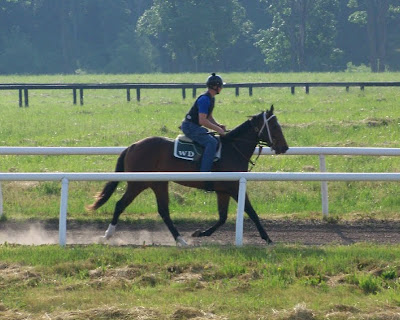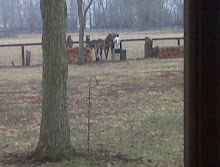Did anyone blame Churchill Downs or the track surface for the incident?
Of course not, so why are we now wasting time ‘certifying’ tracks in an effort to avoid another such catastrophe?
Courtesy of www.ratherrapid.blogspot.com we know that:
-Eight Belles worked and raced less than any other entry in the field at just 52 furlongs total for the first 5 months of 2008. Next lowest was Big Brown at 56 furlongs, and both careers ended soon after their heroic Derby efforts.
-Eight Belles worked/raced only 1 time each in December and January, and just 2 times in February. But when March comes along, Larry Jones ups the workload 300% for the next 6 weeks prior to her Derby start.
-To hell with paraphrasing, I need to directly quote the RatherRapid blog here as he is much more a horseman than yours truly:
“Now, Jones claims his filly was in perfect health going into the Derby. Unlikely. I will guarantee with my last breath that after that :58 work on 4/27 followed by the 2 minute lick under Jones’ 215 lbs 3 days later that this filly showed significant heat in exactly the area where she fractured.
How do I know this?
Again most trainers will understand you're unable to get away with this sort of back to back work unscathed. Never happens, and in particular would never happen with a filly this young, this tall, and this lightly trained. The probability: Pre-Derby this horse was showing heat in her lower cannons, which will explain why Jones went very easy from 4/30 to the Derby.
By Derby day with the light work the heat would have disappeared and EB's legs somehow passed State Vet inspection. Too bad they never put infrared thermography on her. I feel sure that those fetlocks and lower cannons would have lit up that machine like a Christmas Tree.”
By Derby day with the light work the heat would have disappeared and EB's legs somehow passed State Vet inspection. Too bad they never put infrared thermography on her. I feel sure that those fetlocks and lower cannons would have lit up that machine like a Christmas Tree.”
I just don’t buy the fact that this was ‘just racing’, a bad step, or a fluke accident. I could go along with that if the injury happened to one ankle during some jostling the first quarter of the race. But to break both ankles after the longest and toughest race of her young life – there is something else at work here.
In March 2008 at the Welfare and Safety of the Racehorse Summit in Lexington, the following recommendations were passed on by those in attendance:
Recommendation 2: Catastrophic Injuries
• Promotion of standardized pre-race exam protocol
1. Develop a standardized protocol and procedures for pre-race examinations
Recommendation 4: Education
• Develop continuing education programs for trainers
I offered my assistance, for free, multiple times and was ignored.
• Promotion of standardized pre-race exam protocol
1. Develop a standardized protocol and procedures for pre-race examinations
Recommendation 4: Education
• Develop continuing education programs for trainers
I offered my assistance, for free, multiple times and was ignored.
Here was my proposal:
Many years ago you would have been reading about the spate of deaths in equine endurance racing, where some competitions last 100 miles. In an effort to curb these deaths, the powers that be in that discipline instituted the Cardiovascular Response Index based on heart rate recovery after exercise. Now no horses drop dead in that sport, as they are disqualified if they fail the CRI.
Why can’t we do the same for thoroughbreds?
The basis for my recommended *Pre-Race Cardiovascular Fitness Test for Kentucky Derby length of 1.25miles/10 furlongs*, comes from the following publicized work:
*David W. Freeman, Equine Specialist, Don R. Topliff, Associate Professor of Animal Science, Michael A. Collier, Professor of Surgery, Veterinary Medicine. Monitoring Fitness of Horses by Heart Rate. Oklahoma State University, ANSI-9118
Relevant material from the report:
• The normal resting heart rate of a mature horse is between 30 to 40 beats per minute. Although the resting heart rate in humans can decrease dramatically as a result of physical conditioning, the resting heart rate of horses does not appear to change appreciably with fitness.
• Recovery heart rate below 120 beats per minute at 2 minutes post exercise and below 70 beats per minute at 10 minutes post exercise suggest the horse is adequately conditioned to the level and intensity of exercise.
• One method of monitoring fitness is to graph the heart rate response to an exercise bout of constant speed through the exercise program.
• As a horse becomes more fit, heart rate at a constant speed decreases. It is probable that an injury has occurred if heart rate increases sharply during a specific exercise bout.
• Careful monitoring of heart rate may assist in early detection of injury much sooner than is otherwise possible.
• Elevated heart rates may also be a sign of chronic fatigue, or ‘overtraining’ as it is commonly termed in the industry. The training program may have to be completely stopped and the horse rested for 30 to 60 days if conditioning fatigue persists.
• The normal resting heart rate of a mature horse is between 30 to 40 beats per minute. Although the resting heart rate in humans can decrease dramatically as a result of physical conditioning, the resting heart rate of horses does not appear to change appreciably with fitness.
• Recovery heart rate below 120 beats per minute at 2 minutes post exercise and below 70 beats per minute at 10 minutes post exercise suggest the horse is adequately conditioned to the level and intensity of exercise.
• One method of monitoring fitness is to graph the heart rate response to an exercise bout of constant speed through the exercise program.
• As a horse becomes more fit, heart rate at a constant speed decreases. It is probable that an injury has occurred if heart rate increases sharply during a specific exercise bout.
• Careful monitoring of heart rate may assist in early detection of injury much sooner than is otherwise possible.
• Elevated heart rates may also be a sign of chronic fatigue, or ‘overtraining’ as it is commonly termed in the industry. The training program may have to be completely stopped and the horse rested for 30 to 60 days if conditioning fatigue persists.
For the Kentucky Derby length of 10 furlongs, I would recommend the following:
-Test to encompass 12s/furlong pace at 60-70% of race distance for these elite horses
-1.25 mile race requires 6 furlongs breeze in 1min12sec
-Taken and passed, no less than 3 days before race, no more than 10 – ideal would be 7 days out.
-Recovery heart rate must fall to 120bpm within 2 minutes, and 80bpm within 10 minutes of peak work speed. (2min period reflective of horse being cooled down properly, 10min period reflects fitness level/conditioning of horse for the effort.)
-1.25 mile race requires 6 furlongs breeze in 1min12sec
-Taken and passed, no less than 3 days before race, no more than 10 – ideal would be 7 days out.
-Recovery heart rate must fall to 120bpm within 2 minutes, and 80bpm within 10 minutes of peak work speed. (2min period reflective of horse being cooled down properly, 10min period reflects fitness level/conditioning of horse for the effort.)
In my opinion we must strive to prove that a horse is conditioned appropriately for a 6 furlong effort the week before being asked to race 10 furlongs. Horses that have undiagnosed problems with bone remodeling, tendon or ligament stability, or systemic illness or infection will not pass such a test.
Secondly, with respect to continuing education for trainers, I feel my background in exercise physiology would be a big help in the desire for future catastrophic injury prevention.
From my experiences with local trainers, I understand there is a great deal of reticence to listen to new ideas. However, I do believe that my focus on enhancing racing performance is more attractive to horsemen of all backgrounds – the promise of faster horses earning a greater purse share can then be used to promote sounder, healthier racehorses.
My final enclosure is:
*D. M. Nunamaker, VMD. On Bucked Shins. Proceedings of the 48th AAEP Annual Convention. Orlando, FL. December 4-8, 2002.
*D. M. Nunamaker, VMD. On Bucked Shins. Proceedings of the 48th AAEP Annual Convention. Orlando, FL. December 4-8, 2002.
Relevant material from the report:
• Traditional training methods of long, slow gallops for yearlings that result in bucked shins are a major cause of saucer and stress fractures later in life, injuries that can contribute to catastrophic breakdowns when racing.
The above is just one example of the research that has been done to help trainers mold sound and healthy thoroughbreds, but no system is in place to put this scientific work into practical application.
The above is just one example of the research that has been done to help trainers mold sound and healthy thoroughbreds, but no system is in place to put this scientific work into practical application.
Some other topics to include:
-Proper warm up prior to race to decrease chance of injury
-Minimum training threshold necessary to ensure appropriate fitness/injury prevention
-How to spot the signs of overtraining syndrome
-Use of correct nutrition/diet practices to ensure proper recovery from exercise
-Establishing baseline resting heart rate data for each horse as a vital sign
-Proper warm up prior to race to decrease chance of injury
-Minimum training threshold necessary to ensure appropriate fitness/injury prevention
-How to spot the signs of overtraining syndrome
-Use of correct nutrition/diet practices to ensure proper recovery from exercise
-Establishing baseline resting heart rate data for each horse as a vital sign
Here we are in 2011 and the only progress made has been with regards to certifying track surfaces, starting gates, veterinary personnel, etc. – NONE of which was to blame for the demise of Eight Belles in the first place.
Now, you Larry Jones apologists are 100% correct in that he is a great horseman and possibly an even greater human being. But, if he believes the best way to build a sound filly is what he did in early 2008 with Eight Belles, he is sorely mistaken. Going slow with 215lbs aboard is no substitute for race-specific preparation via speedwork.
Please note I am not blaming this trainer, all others do the same.
The great Michael Matz was on HBO’s special entitled ‘Barbaro’ just last week – did you catch his quote after the accident?
“Maybe we had him wound a little bit too tight for this one.”
Hmm, very few preps, no works in between the Derby and Preakness, etc. and two dead horses that could have made history for the right reasons - instead of the wrong ones.
Sounds very familiar to me, but hey at least CD, PIM, and BEL are certified, right?

















